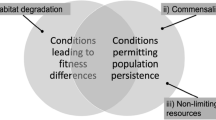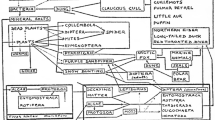Summary
In summary, many extant definitions of the niche concept are based on the geometric metaphor which represents the niche as an object embedded in a geometric space. There are several difficulties with this approach; the activities of organisms are not fully described, certain attributes of the functional aspect of the niche are not represented, the life cycles of organisms are not described, and the heuristic value of the concept diminishes with increasing dimensionality.
An alternative and complementary approach to the niche is the linguistic metaphor. This approach is based on the explanatory objective to explain the assembly of the ecosystems of successional seres from species pools and abiotic environmental factors. The linguistic metaphor suggests that a theory of ecosystem assembly is a generative grammar that associates particular species with environmental features. The niche of a particular species is defined in terms of the rules of a generative-transformational grammar used to derive an hierarchically organized description of that species. This approach also has conceptual difficulties: (1) empirically testing competence theories and distinguishing possible and impossible objects (e.g. species and ecosystems) are difficult, (2) evolutionary processes are difficult to incorporate, (3) the mathematical tools associated with grammars do not have the range of applicability of the mathematical tools associated with the geometric metaphor, and (4) the productions (hierarchical trees) of a grammar are not easily visualized.
The geometric and linguistic metaphors of the niche should be viewed as complementary pictures of the same object. The geometric representation is most adept at describing community dynamics and stability, niche overlap, and organism response to abiotic environments. The linguistic metaphor represents well organism activities, niche dynamics, and ecosystem assembly.
Similar content being viewed by others
References
Andrewartha, H. G. and L. C. Birch: 1954, The Distribution and Abundance of Animals, Univ. Chicago Press, Chicago.
Billings, W. D. 1952: ‘The environmental complex in relation to plant growth and distribution’, Quart. Rev. Biol. 27, 251–265.
Bock, W. J. and G. von Wahlert: 1965, ‘Adaptation and the form-function complex’, Evolution 19, 269–299.
Botkin, D. B.: 1977, ‘A functional approach to the niche concept in forest communities’, in G. S. Innis (ed.), New Directions in the Analysis of Ecological Systems. Part 2, pp. 149–158. Soc. Comput. Simul., La Jolla, CA.
Brown, J. H. and D. W. Davidson: 1977, ‘Competition between seed eating rodents and ants in desert ecosystems’, Science 196, 880–882.
Chomsky, N.: 1957, Syntactic Structures, Mouton, The Hague.
Christiansen, F. B. and T. M. Fenchel: 1977, Theories of Populations in Biological Communities, Springer-Verlag, Berlin.
Clausen, J. D., D. Keck, and W. M. Hiesey: 1948, ‘Experimental studies on the nature of species. III. Environmental responses of climatic races of Achillea’. Carnegie Inst., Washington Pub. No. 242.
Cody, M. L.: 1974, Competition and the Structure of Bird Communities, Princeton Univ. Press, Princeton, N.J.
Collier, B. D., G. W. Cox, A. W. Johnson, and P. C. Miller: 1973, Dynamic Ecology, Prentice Hall, Englewood Cliffs, N.J.
Colwell, R. K. and E. R. Fuentes: 1975, ‘Experimental studies of the niche’, Ann. Rev. Ecol. Syst. 6, 281–310.
Dawkins, R.: 1976, ‘Hierarchical organization: A candidate principle for ethology’, in P. P. G. Bateson and R. A. Hinde (eds.), Growing Points in Ethology, Cambridge Univ. Press, Cambridge.
Dretske, F. I.: 1974, ‘Explanation in linguistics’, in D. Cohen (ed.) Explaining Linguistic Phenomena, John Wiley & Sons, N.Y. pp. 21–41.
Elton, C. S.: 1927, Animal Ecology, Macmillan, NY.
Emlen, J.: 1973, Ecology: An Evolutionary Approach, Addison-Wesley Pub. Co., Reading, MA.
Grinder, J. T. and S. H. Elgin: 1973, Guide to Transformational Grammar: History, Theory, Practice, Holt, Rinehard, and Winston, Inc., N.Y.
Grinnell, J.: 1928, ‘Presence and absence of animals’, Univ. California Chronicle 30, 429–450.
Gross, M.: 1972, Mathematical Models in Linguistics, Prentice Hall, Englewood Cliffs, N.J.
Haefner, J. W.: 1977, ‘Generative grammars that simulate ecological systems’, in G. S. Innis (ed.), New Directions in the Analysis of Ecological Systems Part 2, pp. 189–211, Soc. Comput. Simul., La Jalla, CA.
Haefner, J. W.: 1979, ‘Generative grammars and general systems’, in F. Pichler (ed.), Progress in Cybernetics and Systems Research, Vol. 5. Hemisphere Pub. Corp., NY. (in press).
Hespenheide, H. A.: 1975, ‘Prey characteristics and predator niche width’, in M. L. Cody and J. M. Diamond (eds.), Ecology and Evolution of Communities, pp. 158–180, Belknap Press, Cambridge, MA.
Hull, D. L.: 1974, Philosophy of Biological Science, Prentice-Hall Inc., Englewood Cliffs, NJ.
Hutchinson, G. E.: 1957, ‘Concluding remarks’, Cold Spr. Harb. Symp. Quant. Biol. 22, 415–427.
Hutchinson, G. E.: 1978, An Introduction to Population Ecology, Yale Univ. Press, New Haven.
Kauffman, S.A.: 1976, ‘Articulation of parts explanation in biology and the rational search for them’, in M. Grene and E. Mendelsohn (eds.) Topics in the Philosophy of Biology, pp. 245–263 (Boston Studies in the Philosophy of Science, Vol. 27), D. Reidel Pub. Co., Dordrecht, Holland.
Krebs, C. J.: 1972, Ecology: The Experimental Analysis of Distribution and Abundance, Harper & Row, NY.
Kroes, H. W.: 1977, ‘The niche structure of ecosystems’, J. Theoret. Biol. 65, 317–326.
Kulesza, G.: 1975, ‘Comment on “Niche, habitat, and ecotope”’, Amer. Nat. 109, 476–479.
MacArthur, R. H.: 1968, ‘The theory of the niche’, in R. C. Lewontin (ed.), Population Biology and Evolution, pp. 159–176, Syracuse Univ. Press, Syracuse, NY.
Macfadyen, A.: 1963, Animal Ecology: Aims and Methods, Sir Isaac Pitman and Sons, Ltd., London.
Maelzer, D. A.: 1965a, ‘A discussion of components of environment in ecology’, J. Theoret. Biol. 8, 141–162.
Maelzer, D. A.: 1965b, ‘Environment, semantics and system theory in ecology’, J. Theoret. Biol. 8, 395–402.
Maguire, B.: 1973, ‘Niche response structure and the analytical potentials of its relationship to the habitat’, Amer. Nat. 107, 213–246.
Mason, H. L. and J. H. Langenheim: 1957, ‘Language analysis and the concept “environment”’, Ecology 38, 325–340.
Nagel, E.: 1961, The Structure of Science: Problems in the Logic of Scientific Explanation, Harcourt, Brace, and World, Inc. NY.
Nagel, E.: 1977, ‘Teleology revisited’, The Journal of Philosophy 74, 261–301.
Odum, E. P.: 1971, Fundamentals of Ecology, W. B. Saunders, Philadelphia, PA.
Pianka, E. R.: 1973, ‘The structure of lizard communities’, Ann. Rev. Ecol. Syst. 4, 53–74.
Pianka, E. R.: 1974, Evolutionary Ecology, Harper and Row, NY.
Pielou, E. C.: 1974, Population and Community Ecology: Principles and Methods, Gordon and Breach, NY.
Pielou, E. C.: 1975, Ecological Diversity, John Wiley, NY.
Rejmanek, M. and J. Jenik: 1975, ‘Niche, habitat, and related ecological concepts’, Acta Biotheoret. 24, 100–107.
Ricklefs, R. W.: 1973, Ecology, Chiron Press, Newton, MA.
Roughgarden, J.: 1972, ‘Evolution of niche width’, Amer. Nat. 106, 683–718.
Ruse, M.: 1973, The Philosophy of Biology, Hutchinson University Library, London.
Schank, R. C.: 1973, ‘Identification of conceptualizations underlying natural language’, in R. C. Schank and K. M. Colby (eds.), Computer Models of Thought and Language, pp. 187–247, W. H. Freeman and Co., San Francisco
Schank, R. C. and K. M. Colby (eds.): 1973, Computer Models of Thought and Language, W. H. Freeman and Co., San Francisco.
Schank, R. C. and Y. Wilks: 1974, ‘The goals of linguistic theory revisited’, Lingua 34, 301–326.
Schoener, T. W.: 1974, ‘Competition and the form of habitat shift’, Theor. Pop. Biol. 6, 265–307.
Smith, K. T.: 1971, Primer of Modern Analysis, Bogden and Quigley, Tarrytown-on-Hudson, NY.
Southwood, T. R. E.: 1977, ‘Habitat, the templet for ecological strategies?’, J. Anim. Ecol. 46, 337–365.
Tinbergen, N.: 1951, The Study of Instinct, Oxford Univ. Press, Oxford.
Turesson, G.: 1930, ‘The selective effect of climate upon the plant species’, Hereditas 14, 99–152.
Vandermeer, J. H.: 1972, ‘Niche theory’, Ann. Rev. Ecol. Syst. 3, 107–132.
Whittaker, R. H., S. A. Levin, and R. B. Root: 1973, ‘Niche, habitat, and ecotope’ Amer. Nat. 107, 321–338.
Whittaker, R. H., S. A. Levin, and R. B. Root: 1975, ‘On the reasons for distinguishing “Niche, habitat, and ecotope”’, Amer. Nat. 109, 479–482.
Whittaker, R. H. and G. M. Woodwell: 1972, ‘Evolution of natural communities’, in J. A. Wiens (ed.), Ecosystem Structure and Function, pp. 137–156, Oregon State Univ. Press, Corvallis, OR.
Williams, E. E.: 1972, ‘The origin of faunas. Evolution of lizard congeners in a complex island fauna. A trial analysis’, in T. Dobzhansky, M. K. Hecht, and W. C. Steere (eds.), Evolutionary Biology, Vol. 6, pp. 47–89, Appleton, Century, Crofts, NY.
Wimsatt, W. C.: 1972, ‘Teleology and the logical structure of function statements’, Stud. Hist. Phil. Sci. 3, 1–80.
Winograd, T.: 1973, ‘A procedural model of language understanding’, in R. C. Schank and K. M. Colby (eds), Computer Models of Thought and Language, pp. 152–186, W. H. Freeman and Co., San Francisco.
Wuenscher, J. E.: 1969, ‘Niche specification and competition modeling’, J. Theoret. Biol. 25, 436–443.
Yoshiyama, R. M. and J. Roughgarden: 1977, ‘Species packing in two dimensions’, Amer. Nat. 111, 107–121.
Author information
Authors and Affiliations
Rights and permissions
About this article
Cite this article
Haefner, J.W. Two metaphors of the niche. Synthese 43, 123–153 (1980). https://doi.org/10.1007/BF00413860
Issue Date:
DOI: https://doi.org/10.1007/BF00413860




